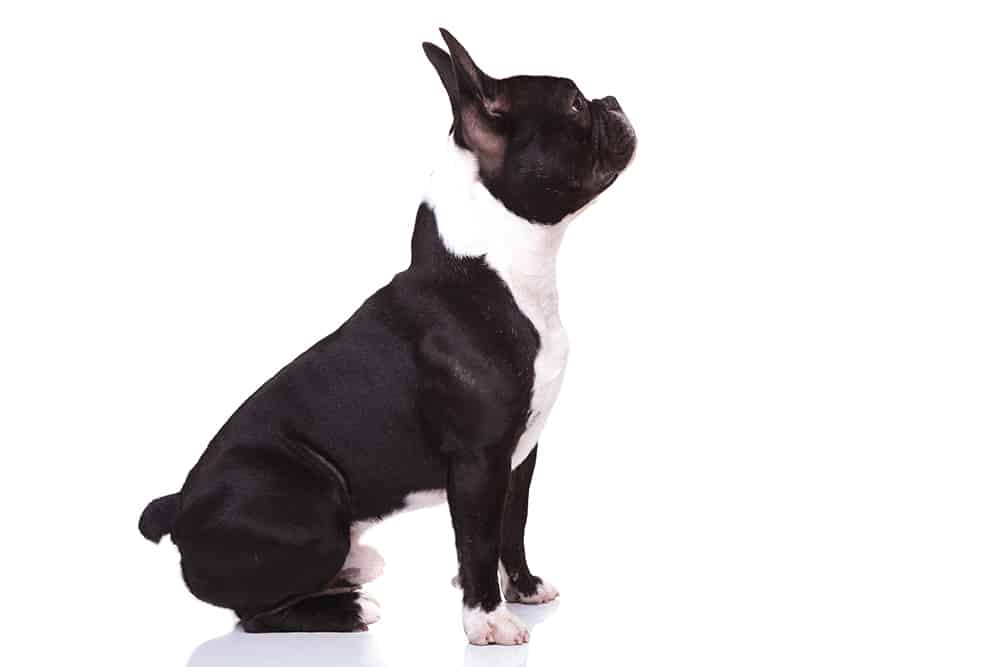French Bulldogs are one of the most popular breeds of dog around today. They are loved for their cuddly companionship, their small size and their distinctive look.
Developed as a smaller version of the incredibly popular bulldog breed, the Frenchies are instantly recognizable for their flat, pug-like face shape, their large puppy eyes, their famous bat ears and their short, stocky build.
Yet, many people feel conflicted about the French Bulldog’s lack of a tail.

Some Frenchies appear to have no tail whatsoever and others have a stumpy tail that looks as though it has been cut or docked. The truth is that these woofers are born without their waggers – or with very small ones at least.
Their short tails are not so much ‘natural’ as they are the result of careful selective breeding practices that have taken place over years and years.
Many owners find these little stumpies adorable, however, the shortness and shape of these tails is the cause of much concern to others, who worry about the health issues that such short, screwtails create.
Read on to discover the tall tale behind the French Bulldog’s very tiny tail.
Are French Bulldogs’ Tails Docked?
No. It is a common misconception that French Bulldogs have their tails cut or docked at birth, however this is not the case. Frenchies are in fact born with unusually stumpy tails compared to the usual long tail that you would expect to see on a dog.
These tails can be short and straight, corkscrew shaped or curved, and they are the result of selective breeding over many, many years.
What Shape Is A French Bulldog’s Tail?
French Bulldogs tend to have one of three types of tail:
- The most common is the short, straight, downward angled tail.
- The second is the corkscrewed, stumpy tail.
- The third is the tapered tail which is thick at the root and narrows to a tip.
Are French Bulldogs Born With A Tail?
Yes. Little baby Frenchie pups have the cutest little baby tails, but they are so small you would be forgiven for thinking that they hadn’t any tail at all.
When they are first born the French Bulldog’s tail appears like a little nubbin on it’s butt, and it grows ever so slightly longer as the puppy matures into a dog. When full grown, the Frenchie’s tail should be long enough to cover its anus.
Can French Bulldogs Wag Their Tails?
Sadly Frenchies are unable to wag their tails as they are simply too short to swish from side to side.
Some Frenchies manage to achieve a little bit of motion in the tail stump, but the majority of this breed twitch their bottoms from side to side instead. This rear end wiggle is a fun characteristic movement that demonstrates a Frenchie is happy.

To show excitement they tend to jump up and down and bounce about because they lack the facility to whip their tails back and forth as other breeds can.
These beautiful dogs also have incredibly expressive eyes which sit far forward on their faces, and it is through these that they communicate much of what they are feeling. When nervous or alert their ears will become rigid as opposed to relaxed.
What Are The AKC Breeding Standards For French Bulldog Tails?
The American Kennel Association states in their breeding standards for French Bulldogs, that the tail should be straight or screwed but should never be curly, and that it should be long enough to cover the anus and not rise above a horizontal plane.
The tail should be short and lie flat to the dog’s buttocks. It should be set low on the rear, and if too high up the back it is considered a fault. In the same way, a tail that is too short is considered a breeding fault as is a tail that is too long.
These standards have to be met if you wish to enter your French Bulldog into AKC competitions or receive their official recognition of you as a breeder.
Why Do French Bulldogs Have Short Tails?
French Bulldogs’ tails are short due to deliberate breeding processes. Initially these dogs were used to catch rats in inner city areas and their longer tails left them vulnerable to rat bites and infection.
A dog with an infection could easily die, or at the very least was no longer able to do its job, so rat catchers tended to prefer Frenchies with short tails. As well as ratting, French Bulldogs were used as fighting dogs and here again their tails left them prone to bites from other dogs.
It was for these reasons that breeders began to select short tailed partners as mates and thus encourage an ever shorter and stumpier tailin the gene-pool.
After a time, however, French Bulldogs stopped being working dogs and became domestic pets instead. Breeders continued to shorten their tails for purely aesthetic reasons, because the short tail was seen to be neat and cute.
The screw-type tail was considered superior and more refined by kennel associations and competitions and the Frenchie’s tail became shorter and more curved over the years.
These days Frenchies are loved for their docile nature and cuddly bodies. Owners and authorities alike are backing away from the notion that short, screw tails are preferred due to health problems caused by the inbreeding process and the shape of the tail itself.
What Are Tail Pockets?
Not all French Bulldogs have tail pockets, but for those that do they are a little wrinkle of skin that sits below the tail but above the rectum.
As the skin is folded over these pockets are not self-cleaning like the rest of the Frenchie’s coat and are therefore prone to gathering dirt and bacteria over time.
Sadly, these tail pockets can become infected if they are not cleaned regularly.
The symptoms of infection include pus forming, swelling, severe itching and a foul odor, so it really can be very unpleasant for a pooch and can cause much pain. An infected tail pocket can even become life-threatening if left untreated.
If a tail pocket infection takes hold your dog will have to be treated by a vet and will usually be prescribed a course of antibiotics which will clear the problem up in no time. However, in really serious cases surgery might be the only answer, with the infected skin being removed to stop the spread.
To prevent infection you simply need to wash your French Bulldog’s tail pocket with warm water and soap. A mild, baby soap will work best (because your Frenchie is just like a baby after all).
Alternatively, you can use baby wipes to clean the area if they are unscented.
Make sure that the water isn’t too hot, but a pleasant temperature for you to touch, then use a cotton ball or flannel to dab in and around the pocket and remove any dirt that may have built up.
Be sure to lift up the tail to clean the pocket thoroughly and not miss any bits of dirt that might be hiding under there.
What Are Signs Of An Infected Tail Pocket?
If your French Bulldog develops a tail pocket infection they may display some tell tale signs.
Firstly, you may detect an unpleasant smell coming from your pooch. Secondly, you may notice your pooch driving or sliding their backside along the ground. This movement can be a sign of worms as well.
Does A Short Tail Cause Health Problems?
As well as affecting the French Bulldog’s ability to display their canine emotions, there is another unexpected health issue caused by the shortness of their tails and this is sunburn.
That’s right, Frenchies suffer from burnt butts more than other breeds with longer tails because their rear ends are more exposed to sunlight and UV rays.
They can get serious sun damage over long periods of exposure so it is important to put a layer of mild, children’s sunscreen on your Frenchie’s bottom before you head out in the midday sun.
Does A Screwtail Cause Health Problems?
Sadly, the French Bulldog’s tail can cause this breed some serious health concerns.
These concerns relate to screw-tailed Frenchies in particular, as the curved nature of their tails means that the bones don’t always align correctly in the spine.
This can lead to deformity and instability in the spinal column which in turn can cause terrible pain and discomfort to the dog. In the worst cases, this misalignment has led to spinal damage and even nerve damage resulting in walking difficulties and even paralysis of the limbs.

Hemivertebra is the official name of the spinal defect suffered by many French Bulldogs due to their screw-type tails.
Puppies generally develop the disease when they are around 9 months old and it cannot be prevented because it is a genetic condition. The condition relates to the vertebrae, which are the tiny bones that make up the dog’s spine from their tail to their neck.
When the spinal cord is forming the twisting of the tail can warp its alignment and create a deformity that will inhibit the dog’s mobility and can affect their ability to control their rear muscles properly.
A dog’s tail is used to support its rear muscle groups and also to stabilize the vertebrae. Without their tails dogs can suffer from terrible illnesses such as urinary and fecal incontinence, hernias and dilation of the rectum.
These health problems are directly related to the selective breeding process and the way that breeders have tried to make the screwtail the dominant look among French Bulldogs.
They are essential spinal defects created by inbreeding and are therefore entirely unnatural and avoidable.
In mild cases where only a few vertebrae are affected the symptoms may not be noticeable or may be manageable with the help of painkillers. In more severe cases, your Frenchie may need an X ray, or even an MRI or CT scan to be conducted by a veterinarian in order to determine the breadth of the problem.
Then surgery may be necessary to straighten out the vertebrae. All this can be very costly for you and very traumatic for your dog, which is why many breeders and animal welfare activists advocate for the straight tail initiative.
What Is The French Bulldog Straight Tail Initiative?
The Straight Tail Initiative began in the UK in 2010 by the National Kennel Club, and has since received recognition and support from other leading kennel clubs including the AKC.
It proposed a move away from the corkscrew tail that has become increasingly popular over the years, and back towards straighter tails that are healthier and safer for the breed overall.
French Bulldogs did originally have straight, drop-down tails before they were phased out via selective breeding processes in favor of the more ornate screwtail.
What Is A Natural Bobtail?
A natural Bobtail is the term used to describe an animal whose tail grows unusually short or does not grow at all due to a genetic mutation.
This mutation in dogs is not naturally occurring (as it seems to be in the bobtail cat for example) but has been encouraged and cultivated through centuries of docking and selective breeding.
The natural bobtail gene is the C189G mutation and it can be either dominant or recessive.
Which Breeds Are Born Without A Tail?
Boston Terriers, Pembroke Welsh Corgis, Australian Stumpy Tail cattle dogs, Braque du Bourbonnais, Brittany Spaniel, English Bulldogs and French Bulldogs are all breeds that are born without tails.
Is Tail Docking Illegal In America?
The practice of tail docking is unrestricted in the USA, although it is more closely restricted in other countries and some states such as New York and Vermont have considered passing bills to make the practice illegal on certain breeds.
What Breed Of Dogs Have Their Tails Docked?
As the practice of tail docking is not illegal in the USA, any breed of dog could technically have its tail docked however the procedure is most often used for working dogs like pointers, terriers and spaniels and sheepdogs.
Boxers, Dobermanns and Rottweilers are commonly known to have their tails docked for aesthetic reasons.
What Are The Reasons For Docking A Dog’s Tail?
Tail Docking For Prevention Of Injuries
Most working dogs have their tails docked to prevent them from sustaining injuries whilst out hunting, retrieving, sniffing or shepherding.
Because many of these activities take place in dense forest or undergrowth, working dogs with long tails can sustain bruises, cuts, bleeding and even some cases of severance when their undocked tails catch on bracken, branches and roots and trees.
In this instance it is fairer to dock their tail and allow them to work more effectively, quickly and often more quietly in the great outdoors, whilst also alleviating any risk of injury and infection through cuts and bruising.
Tail Docking For Medical Reasons
Some dogs have their tails amputated for medical reasons. This can be due to an injury or illness that causes their tails to be painful and uncomfortable. Veterinarians can use their discretion and professional opinion to decide when amputation is necessary.
Tail Docking For Aesthetic Reasons
Some owners have their dog’s tail docked for purely aesthetic reasons, because they think it creates a particularly ferocious and intimidating look.
Although some would argue that this increases the impact of a guard dog, the procedure is purely cosmetic and has no actual effect on a dog’s ability to guard a home and alert their owner to danger.
The practice of tail docking for aesthetic reasons is often paired with ear cropping, which is when a dog’s ears are cut and pinned into a spiked and upright position to make them appear savage and scary.
Ear docking is illegal in many countries and is strongly opposed by animal welfare activists.
What Are The Cons Of Docking A Dog’s Tail?
There is plenty of evidence to suggest that the procedure of docking a dog’s tail causes significant pain to puppies when it is carried out.
What is more, if the operation is poorly executed then a dog can suffer from chronic pain throughout their lives, which is why docking should only be performed by professional veterinarians.
Dogs also use their tail as a form of canine expression through which they communicate feelings to each other and the wider world (just think of how they wag their tails when they are happy and have their tail between their legs when they are sad).
When a dog’s tail is docked they are denied this form of expression and can struggle to communicate effectively, which can cause frustration and sadness to these undeserving animals.
As it can diminish their ability to communicate with their own kind they can often suffer from exclusion by other dogs, and if misunderstandings arise it can result in unnecessary fighting and violence between dogs.




